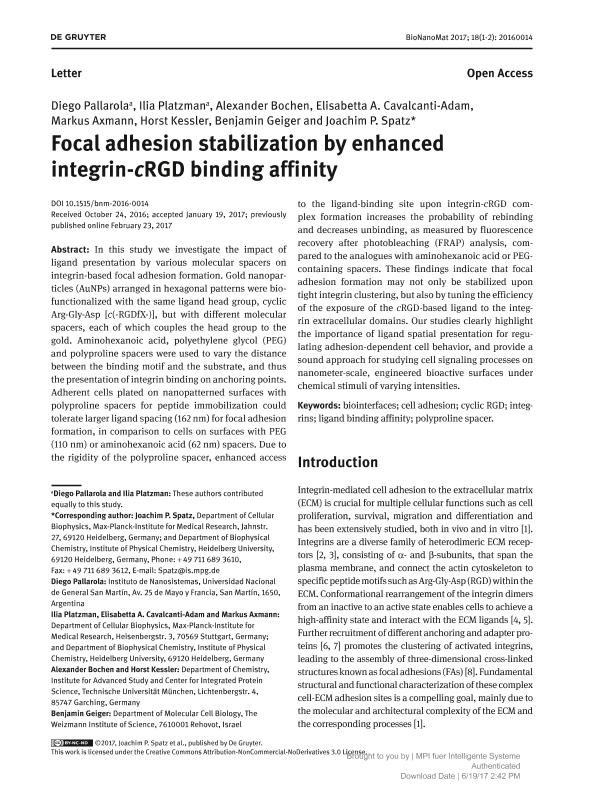Mostrar el registro sencillo del ítem
dc.contributor.author
Pallarola, Diego Andres

dc.contributor.author
Platzman, Ilia
dc.contributor.author
Bochen, Alexander
dc.contributor.author
Cavalcanti Adam, Elisabetta A.
dc.contributor.author
Axmann, Markus
dc.contributor.author
Kessler, Horst
dc.contributor.author
Geiger, Benjamin
dc.contributor.author
Spatz, Joachim P.
dc.date.available
2018-04-03T21:12:26Z
dc.date.issued
2017-01
dc.identifier.citation
Pallarola, Diego Andres; Platzman, Ilia; Bochen, Alexander; Cavalcanti Adam, Elisabetta A.; Axmann, Markus; et al.; Focal adhesion stabilization by enhanced integrin-cRGD binding affinity; De Gruyter; BioNanoMaterials; 18; 1-2; 1-2017; 1-13; 20160014
dc.identifier.issn
2193-0651
dc.identifier.uri
http://hdl.handle.net/11336/40604
dc.description.abstract
In this study we investigate the impact of ligand presentation by various molecular spacers on integrin-based focal adhesion formation. Gold nanoparticles (AuNPs) arranged in hexagonal patterns were biofunctionalized with the same ligand head group, cyclic Arg-Gly-Asp [c(-RGDfX-)], but with different molecular spacers, each of which couples the head group to the gold. Aminohexanoic acid, polyethylene glycol (PEG) and polyproline spacers were used to vary the distance between the binding motif and the substrate, and thus the presentation of integrin binding on anchoring points. Adherent cells plated on nanopatterned surfaces with polyproline spacers for peptide immobilization could tolerate larger ligand spacing (162 nm) for focal adhesion formation, in comparison to cells on surfaces with PEG (110 nm) or aminohexanoic acid (62 nm) spacers. Due to the rigidity of the polyproline spacer, enhanced access to the ligand-binding site upon integrin-cRGD complex formation increases the probability of rebinding and decreases unbinding, as measured by fluorescence recovery after photobleaching (FRAP) analysis, compared to the analogues with aminohexanoic acid or PEGcontaining spacers. These findings indicate that focaladhesion formation may not only be stabilized upon tight integrin clustering, but also by tuning the efficiencyof the exposure of the cRGD-based ligand to the integrin extracellular domains. Our studies clearly highlightthe importance of ligand spatial presentation for regulating adhesion-dependent cell behavior, and provide asound approach for studying cell signaling processes on nanometer-scale, engineered bioactive surfaces underchemical stimuli of varying intensities.
dc.format
application/pdf
dc.language.iso
eng
dc.publisher
De Gruyter

dc.rights
info:eu-repo/semantics/openAccess
dc.rights.uri
https://creativecommons.org/licenses/by-nc-nd/2.5/ar/
dc.subject
Biointerfaces
dc.subject
Cell Adhesion
dc.subject
Cyclic Rgd
dc.subject
Integrins
dc.subject
Ligand Affinity
dc.subject
Polyproline Spacer
dc.subject.classification
Otras Ciencias Químicas

dc.subject.classification
Ciencias Químicas

dc.subject.classification
CIENCIAS NATURALES Y EXACTAS

dc.title
Focal adhesion stabilization by enhanced integrin-cRGD binding affinity
dc.type
info:eu-repo/semantics/article
dc.type
info:ar-repo/semantics/artículo
dc.type
info:eu-repo/semantics/publishedVersion
dc.date.updated
2018-04-03T18:42:03Z
dc.identifier.eissn
2193-066X
dc.journal.volume
18
dc.journal.number
1-2
dc.journal.pagination
1-13; 20160014
dc.journal.pais
Alemania

dc.journal.ciudad
Berlín
dc.description.fil
Fil: Pallarola, Diego Andres. Universidad Nacional de San Martin. Instituto de Nanosistemas; Argentina. Consejo Nacional de Investigaciones Científicas y Técnicas; Argentina
dc.description.fil
Fil: Platzman, Ilia. Max-Planck-Institute for Medical Research; Alemania
dc.description.fil
Fil: Bochen, Alexander. Technische Universitat Munchen; Alemania
dc.description.fil
Fil: Cavalcanti Adam, Elisabetta A.. Max-Planck-Institute for Medical Research; Alemania
dc.description.fil
Fil: Axmann, Markus. Max-Planck-Institute for Medical Research; Alemania
dc.description.fil
Fil: Kessler, Horst. Technische Universitat Munchen; Alemania
dc.description.fil
Fil: Geiger, Benjamin. Weizmann Institute of Science. Department of Molecular Cell Biology; Israel
dc.description.fil
Fil: Spatz, Joachim P.. Max-Planck-Institute for Medical Research; Alemania
dc.journal.title
BioNanoMaterials
dc.relation.alternativeid
info:eu-repo/semantics/altIdentifier/url/https://www.degruyter.com/view/j/biomat.2017.18.issue-1-2/bnm-2016-0014/bnm-2016-0014.xml
dc.relation.alternativeid
info:eu-repo/semantics/altIdentifier/doi/http://dx.doi.org/10.1515/bnm-2016-0014
Archivos asociados
